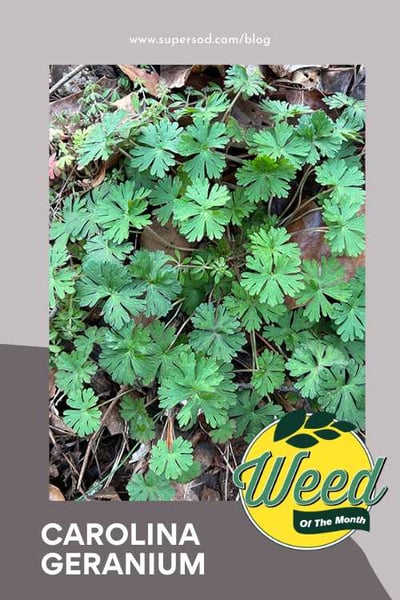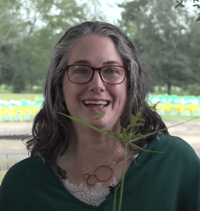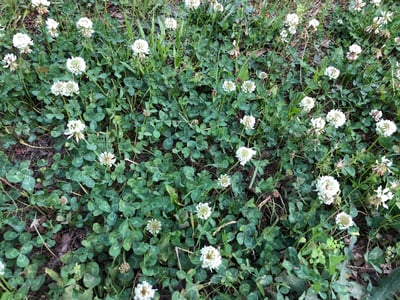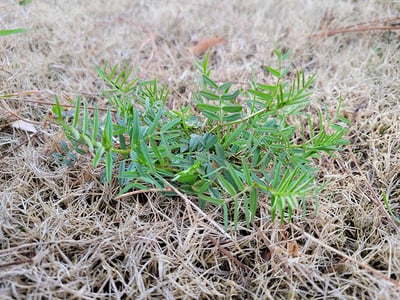
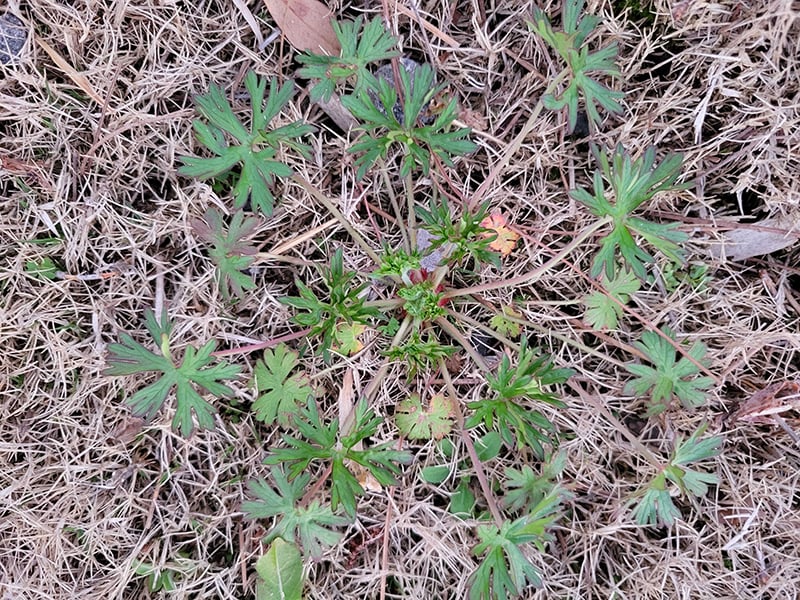
This is not your grandmother's geranium; this is your lawn's geranium!
Grandma's geranium is Zonal geranium, a tried-and-true plant for summertime window boxes and patio pots. Its scientific name is Pelargonium. This is not the plant we will be discussing.
The native wildflower and lawn weed is Geranium carolinianum, a true geranium also known as Carolina geranium, wild geranium, or Carolina cranesbill.
Today, we will discuss Carolina geranium and how to identify it, control it, and prevent it from growing in your lawn.
Carolina geranium ID Features:
To control Carolina geranium, we first need to learn how to identify it.
- Family: Geraniaceae
- Habit: basil rosette when young, as the plant matures it develops several stems from the basil rosette; bushy (not trailing or spreading)
- Stems: partially rosy red or mauve colored, hairy
- Roots: taproot
- Leaves: pretty palmate leaves with 5 to 7 deeply cut lobes, each lobe is again deeply cut so it’s an open, lacy leaf born on long petioles, 1-2” wide; they sometimes turn red during cold weather
- Flowers: 5 petals, tiny, much less showy than the garden variety, white, pale pink, or pale lavender
- Fruit: called cranesbill because of a “beak” on the 1/2" long fruit capsule, they reproduce from the seeds contained in these capsules
Carolina geranium is a winter annual or biennial. In my Zone 8a climate, I see tiny seedlings in the fall, with 1-2’ tall plants by springtime. They shoot up during warm spells!
Carolina geranium seedling in a mulch bed (mulch layer is too thin). This photo was taken in January; the seed germinated the prior autumn (3-4 months ago).
Carolina geranium's small flowers are white, pale pink, or pale lavender.
Carolina geranium seedling in a natural area. This photo was also taken in January. Due to the size, it's likely this is a biennial form that germinated two autumns prior (15-16 months ago).
Mature Carolina geranium plant that is about to flower and go to seed. The plant intertwined with little white flowers on it is chickweed (vetch is also mixed up in there).

Taproot on a Carolina geranium seedling.
Carolina geranium is native throughout eastern North America, from Canada to way down in Key West, spanning almost all the plant hardiness zones from Zone 2 to 11.
It's a common weed in lawns and along roadsides because, like most weeds, it likes areas disrupted my mankind. If your lawn has dry or wet soil, full sun or partial shade, or soils that are sandy, clay, or gravel, you'll likely see Carolina geranium. Those conditions account for most landscapes so you'll probably see this weed in your lawn, or nearby.
Unlike many other lawn weeds like annual poa, wild geranium doesn't thrive under foot traffic. So you'll likely see this in border areas that aren't walked on as much or mown as much.
Learn more about Carolina geranium from these websites:
- NC State Extension Service: https://www.turffiles.ncsu.edu/weeds-in-turf/carolina-geranium/
- Clemson University Extension Service: https://hgic.clemson.edu/factsheet/carolina-geranium/
Eat it or Treat it - How to Control Carolina Geranium
From what I read, Carolina geranium is a medicinal plant and a pollinator plant. If you're trying to balance a beautiful lawn with other interests, such as beekeeping, you may consider a fall application of pre-emergent herbicide only on your lawn, while keeping your flower beds a little wilder by allowing this weed to grow there. Just a thought.
Carolina Geranium Prevention:
- Pre-emergent herbicide: Carolina geranium spreads by seeds, so pre-emergents work well to control burgeoning populations of geraniums. The time to spread pre-emergents to stop this winter weed is in September/October. You can order pre-emergent directly from us in our herbicide store.
- Prevent wild geraniums in beds with thick layers of mulch and by cultivating a thick, healthy lawn so seeds don't have a place to germinate.
- If bald spots develop in your lawn, correct the underlying problem, and get individual rolls of sod and cover those bare spots before more weeds germinate there.
Manual Removal of Carolina Geranium:
- Hand pull: Yes, Carolina geranium has a taproot, but don't let that daunt you. The taproot will not wrench your back. It's easy to pull up! Grab the weed down low at the base and tug. It's even easier after a rain when the ground is wet.
- Mow plants to keep plants from going to seed. Mowing your lawn even when it's dormant will significantly stunt this weed - it doesn't that kind of harsh treatment, unlike some other weeds that adapt to mowing (especially grassy weeds).
Chemical Control of Carolina Geranium:
- Post-emergent herbicide: We recommend Three-D or any other product with 2,4-D as the active ingredient. Spray them when they are young and you'll use less chemicals. We sell Three-D in our herbicide store.
- If they go to seed before you spray them, they will be back next year when those seeds germinate. Never fear, if they go to seed, just spread pre-emergent in September/October.
Other Geraniums
It's easy peasy to tell this geranium from other weeds – there are no look alikes . . . except other geraniums.
There are many other beloved geraniums for perennial beds that can be purchased from nurseries, such as Geranium maculatum, also known as wild geranium, spotted geranium, wood geranium, or cranesbill.
Cranesbill is a stunning native geranium for perennial beds.
In my garden I find an interesting relative called Geranium dissectum, dissected geranium. It grows in similar environs as Carolina geranium, but it has magenta flowers and the leaves are deeply cut into pencil-thin lobes, rather than the round palm-like leaves of Carolina geranium. Dissected geranium is not native to the US and is actually an invasive species, so don't hesitate to eradicate it.
Dissected geranium - note the magenta flower and deeply dissected palmate leaves. Vetch, with pinnately compound leaves, is intertwined, so don't let that fool you!
Whatever geraniums you have, if they are in your lawn, you probably don’t want them there. Thankfully, their eradication methods are the similar for all species.
Questions? Leave a comment below.
If you're a weed aficionado like me, check back here for future weed profiles. Until then, happy weeding!
All photos by Hillary Thompson, except the header photo by Nina Johnson, Marketing Manager, and the photo of Geranium maculatum provided by Brie Arthur.
